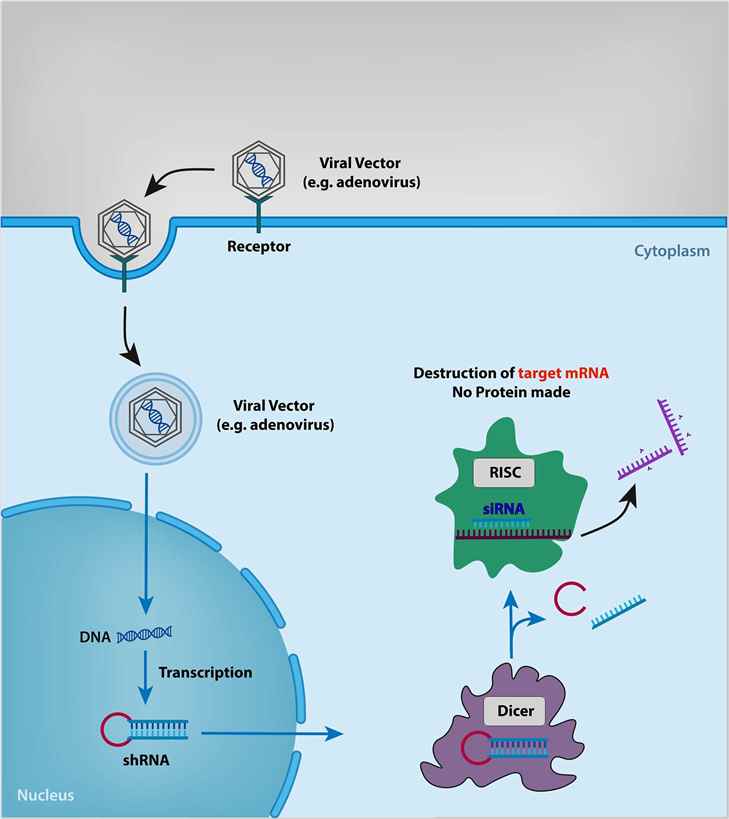Viral vector refers to a virus-based vector and is currently one of the most commonly used methods of gene introduction. Through genetic modification of the viral genome, it can carry foreign target genes and related viral elements, and be packaged into virus particles, and then infect the host, causing the carried foreign genes to be expressed in the host.
The genome of a virus can be divided into coding and non-coding regions. Among them, the coding region contains essential genes and non-essential genes of the virus, which can express disease-causing structural proteins and non-structural proteins respectively; the non-coding region contains all functional elements required for virus replication and packaging.

Since wild-type viruses are often pathogenic, in order to prevent the viruses used in experiments or treatments from reverting to wild-type, a series of genetic modifications must be made to the viral vectors. For example, deleting non-essential regions of the viral genome, connecting cis-acting elements and trans-acting elements separately to different vectors, or combining essential proteins of different viruses to ensure the safety of experiments to the greatest extent.
Mammalian virus expression systems often contain one or more vectors. After the required vectors are transfected into packaging cells, under the action of trans factors, the cis-acting elements and foreign gene expression cassettes required for virus replication and packaging are It can be packaged to eventually produce virus particles containing foreign genes. After concentration and purification, the virus liquid can be used to infect target host cells or animals to achieve the expression of foreign target genes in the host body.
CD Bioparticles' services with customized transfection strategies, precise designs and modifications of transfection carriers, and advanced technical platforms can help you to solve:
| Lentivirus (LV) | Adenovirus (Ad5) | Adeno-associated virus (AAV) | |
| Virus Size | 0.1um | 80-110nm | 20-26nm |
| Genome | Double Stranded RNA | Double Stranded DNA | Single Stranded DNA |
| Whether to integrate | Integrated | Non-integrated (very low probability of integration) | Non-integrated |
| Carrier Capacity | ~6kb | ~7kb | ~4.7kb |
| Envelope Protein | VSV-G | None | None |
| Carrier System | 1 expression plasmid and 3 packaging plasmids | 1 expression plasmid and 1 helper plasmid | 1 expression plasmid, 1 serotype Rep-cap plasmid, 1 helper plasmid |
| Packaging Cells | 293T cells | 293A cells (provides viral E1 gene) | 293A cells (provides viral E1 gene) |
| Packing | Packaging cells do not lyse and virus is secreted into the supernatant | After virus infection, packaging cells lyse | After virus infection, the packaging cells do not lyse, and virus particles are enriched in the cells. Collect cells before lysing them |
| Express Characteristics | Integrated, long-term expression | Short-term expression, about two weeks | Long term expression in non-dividing cells |
| Expression Time | Slow (2~4 days) | Fast (1~2 days) | Expression is stable for 3 to 4 weeks (animals) |
| Virus Titer | 1E8-1E9 | 1E12-1E13 | 1E10-1E11 |
| Animal Immunogenicity | Low | High | Extremely Low |
| Suitable Platform Experiment | Cells, Animals | Cells | Cells, Animals |
Application candidates:
1. Download the template.
2. Enter product information on the template (maximum number of products: 200).
3. Load the file using selector below.
1. Download the template.
2. Enter product information on the template (maximum number of products: 200).
3. Load the file using selector below.